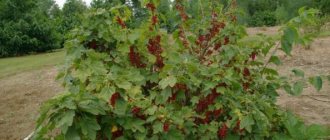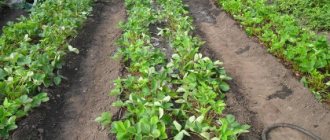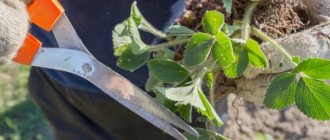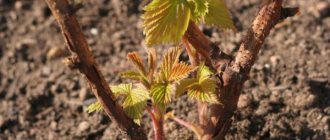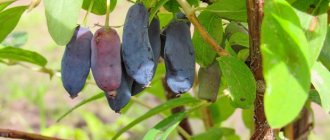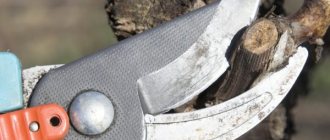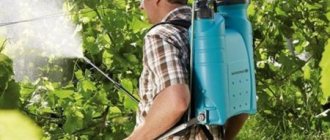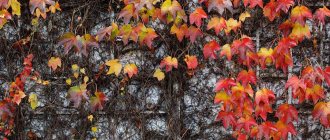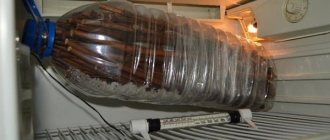Grapes delight many land owners with their beauty and decorative value, and also provide a delicious harvest of aromatic berries. During ripening and fruiting, it consumes a huge amount of minerals from the ground.
And in order to again see strong and healthy vines and an abundance of grapes next year, it is necessary to apply fertilizing and fertilizer in the fall.
For the first two years, no fertilizing is applied, as they are placed in a smart pit. But starting from the third year, it should be fed with potassium, zinc and not forgetting about magnesium and phosphorus.
As a result, this will strengthen the plant’s immunity and allow it to overwinter more comfortably. So how to feed grapes in the fall?
When to feed grapes in the fall
Feeding work begins after the harvest bunches are harvested.
It should be taken into account that the ripening time is different and depends on the variety. Differences in timing for early and late ripening can vary within a month.
First of all, we highlight 3 stages of fertilization:
- We accelerate ripening on a bunch of berries. We treat it diluted in water according to the instructions with Potassium Monophosphate. As a rule, this is the beginning of September.
- We introduce organic matter
- Add a complex of mineral fertilizers.
Fertilizing work depends on the soil:
- For sandy soil, we fertilize the bush every year;
- Sandy loam soils can be fed once every two years;
- Clay - it is enough to apply fertilizer once every three years.
You should not apply fertilizers at a time when the ground is already freezing, since access to the root system is already difficult.
To carry out the procedure correctly, you should not apply fertilizer to the bush itself. However, you need to dig furrows up to 40 cm deep within a radius of 55 cm around the grapes. Add nutrients there.
In this way, the root system will be fully saturated with microelements and enriched. If you supply food to the upper roots, this can affect the branching of the vines.
Important!!! Don't worry about damaging the roots when you dig the trenches. The roots recover quickly.
Potassium and phosphorus affect the metabolic rate, which allows the grapes to recover after harvest. Also, autumn feeding is preparing the bush for a good harvest next season.
However, you should not overdo it, because... Excessive feeding can harm the bush.
Advantages - fertilizing grapes in the fall:
- Firstly, in the spring, when the soil is moist, a complex of applied fertilizers will feed the grapes.
- Secondly, when we loosen the soil around the bush, the roots receive regular care.
- Thirdly, measures are taken to prevent diseases and pests.
When applying fertilizers, you must adhere to certain rules:
- You cannot feed the bush after pruning, because the plant is at rest and sap flow has stopped;
- early ripe varieties need to be fertilized at the end of August, and late ones before the 20th of October;
- Autumn feeding is important - it is potassium monophosphate, which has a beneficial effect on the ripening of the vine. This is done in September by spraying with a solution of 10 grams of fertilizer per 10 liters of water.
Autumn feeding of grapes with ash
If the soil has not become depleted over the season, then it is enough to “feed” it with wood ash, which is simply embedded in the soil during autumn digging. Ash can also be used in the form of a solution: 300 g of wood ash is diluted in 10 liters of water and poured under each bush.
This natural fertilizer contains phosphorus, calcium, potassium, sodium and magnesium in a form accessible to plants. Ash also neutralizes the acidity of the soil and makes garden crops unattractive to insects.
- Wood ash is a natural fertilizer and pest control agent
Secrets of using ash as a fertilizer and an effective insecticide that is safe for human health.
- How to properly feed plants with ash
Everything every gardener should know about feeding plants with ash.
Mineral fertilizers
This type of fertilizing is done at the end of October. Namely, they introduce potassium and phosphorus elements. They can be scattered around the bush and then carefully dug up the ground and watered. If the weather is rainy, then the rain will do the job for you.
Or, dilute phosphorus and potassium in water and water it close to the trunk of the bush.
Experienced winegrowers suggest pouring the solution into a dug hole 30 centimeters deep. So that access to the roots is most effective.
You can make your job easier and prepare your next fall mineral cocktail. For a bucket of water:
Boric acid – 1 gram;
Zinc sulfate – 2 grams;
Superphosphate – 22 grams;
Potassium salt – 10-12 grams, or Potassium sulfate – 25 grams.
Use per 1 square meter of treated area.
Nitrogen fertilizers
This fertilizer cannot be used in the fall, because nitrogen fertilizers stimulate the growth of the green part of the plant. If the bush spends its energy on green mass, then it will not prepare for the winter period. This fertilizer is used in the spring.
Urea is considered the best nitrogen fertilizer. It contains 46% nitrogen. Ammonium nitrate also contains a lot of nitrogen - 34%, ammonium sulfate - 20% and sodium nitrate - 15-17%.
Potash fertilizers
These fertilizers directly affect successful wintering and the harvest of the next period. Potassium affects the formation and ripening of bunches, supports the plant during dry periods, and protects the berries from cracking.
If there is not enough potassium, the foliage may dry out.
What preparations containing potassium are effective for feeding grapes:
Potassium sulfate contains 50% potassium, potassium salt - up to 42%, potassium magnesium - up to 32%. There is no chlorine in these fertilizers.
It is correct to combine both potassium and phosphorus fertilizers in the fall.
Phosphorus supplements
This type of fertilizer affects the first flowers and ovaries. Phosphorus must accumulate in the tissues of the bush, so it must also be applied in the fall.
First of all, a preparation that is suitable for any soil is simple superphosphate (22%). For acidic soil, you can add chalk or lime to the solution. There is also double superphosphate (50%).
For acidic soil, it is good to use phosphate rock (24%).
Available mineral fertilizers for grape care
Owners of private vineyards use the following compositions:
- Superphosphate (monocalcium phosphate) - take 20 tbsp for 3 liters of hot water. l. drug. The resulting concentrate is diluted at the rate of 150 ml per 10 liters of water.
- 20–40 g of potassium sulfate (can be replaced with potassium magnesia), which is diluted in a bucket of water.
- Phosphorite flour. Dosage 300 g per 1 m2. Repeat treatment no earlier than once every 3 years.
- Azofoska. Scattered between rows. No digging required.
- Nitroammophoska. Diluted with water for irrigation.
Complex fertilizers
Complex preparations consist of several mineral components. What are the most common complexes and tested by many winegrowers:
- Ammophos. It dissolves well in water. Percentage of nitrogen and phosphorus (%) - 12:50.
- Nitroammophoska. Used for both basic and additional fertilizers. Proportions of nitrogen, phosphorus, potassium (%) - 17:17:17.
- Azofoska. Proportions of nitrogen, phosphorus, potassium (%) - 16:16:16. Can be used for any type of soil;
- Nitroammophos. Proportions of nitrogen, phosphorus (%) - 16-25:20-23. Good solubility. Used for both basic and additional fertilizers.
Is it possible to feed grapes with them in September? NO! Each preparation contains a large amount of nitrogen, which should not be used in the fall.
We recommend reading the article: “Girl grapes: planting, care, types and cultivation”
Types of fertilizers
During the season, grapes consume nutrients that need to be replenished. Feeding must include:
- Potassium.
- Phosphorus.
- Magnesium.
- Zinc.
- Copper.
Potassium provides frost resistance and allows berries to ripen quickly. It affects the growth of the bush itself. If there is little potassium, the edges of the leaves begin to die. Phosphorus is necessary for the formation of the ovary. Zinc, copper and magnesium increase plant immunity and increase resistance to drought. Thanks to zinc, next year the yield will be higher.
Nitrogen is not needed in the autumn, as it accelerates the growth of the green part of the grapes . It delays the ripening of the vine and preparation for wintering.
With natural ingredients
Organic products are applied first in early autumn. They are used simultaneously with digging, scattered under the bushes. They improve soil properties - looseness, composition, air permeability.
Compost
Rotten plant residues contain a full range of microelements. They are mixed with peat, manure, and phosphate rock. This combination is nutritionally superior to other organic products. It loosens the soil, protects against weeds and helps retain moisture. The product is suitable for perennial grapes and young plants.
Compost is placed in ditches or directly around the grape bushes. The layer thickness is at least 5 cm. Compost is also used for irrigation. To do this, it is diluted in 10 liters of water. The product is made independently from food and garden waste (sawdust, plant debris, peat, straw). Usually it is put in a pit or barrel, where it rots. Before this, it is mixed and compacted. The location is chosen where water is quickly absorbed into the ground. The compost pit is made small - 1.5 m by 1 m.
Manure
Manure or mullein is one of the best organic fertilizers. It gives the grapevine potassium, phosphorus, and nitrogen. Manure enriches the soil with beneficial bacteria and facilitates access to air and water. Human waste is never used fresh. They are allowed to rot or diluted with water. To do this, take 1 part manure and 4 parts water, mix and let it brew for 3 days. For 1 sq.m. It takes up to 10 liters of such liquid.
Another way to apply manure is by placing it in ditches. They are dug between rows of grapes. The grooves are filled to the top with humus mixed with compost and sprinkled with earth. In order not to damage the roots, grooves are not dug in every row, but every other. Subsequently, any watering of the plants is carried out through these grooves.
During the winter, the layer of manure rots and feeds the roots of the grapes. The substances contained in it remain in the soil for several more years. If a dense layer of manure is laid out, it protects the area from weeds. It also does not need to be mulched.
Experienced gardeners never spread fresh manure, as it emits methane and ammonia .
It is important to apply fertilizers correctly. When organic matter is applied superficially, the roots grow close to the surface. In winter, they freeze out, and the deep elements of the root system are left without nutrition.
Chicken droppings
Bird droppings are an affordable and effective fertilizer. Microelements in it are in a form that is easily absorbed. After it, the level of potassium in the soil increases, it is enriched with bacteria. The acidity of the soil is also normalized.
Chicken manure is added dry or a solution is prepared. The dry mixture is suitable in those regions where it gets cold early. It is absorbed into the root system for a long time and nourishes the plant for a long time. Dry litter is purchased ready-made, packaged in plastic bags.
The solution is prepared in a glass container. The process has several stages:
- dilute fresh litter in water in a ratio of 1:4;
- put in a warm place for 10 days;
- diluted again with water in a ratio of 1:10;
- 500 ml of liquid is poured between the bushes.
The infusion should not be poured directly under the bush or onto the rosettes of leaves. To ensure that the fertilizer is well absorbed, the soil is watered abundantly before application. It is also used after rain. At the end of feeding, the area is moistened again with water.
Fertilization with manure is carried out no more than 2 times a year. It contains a high concentration of acids and urea, which can damage the roots of the grapes.
Dry vermicompost
Vermicompost is a common fertilizer. It can be purchased at any gardening store. The mixture contains humus itself, B vitamins, vitamin PP, magnesium, zinc, iron, copper. Potassium humate also contains potassium, phosphorus and nitrogen. The solution is used for root feeding of grapes. First, water the area well, then apply the drug along with watering every 3 days. It is suitable for black soil and peat soil.
A solution is prepared from the preparation: take 3 caps of vermicompost for 1 liter of water. It is advisable to prepare the water - stand or take distilled water. Another option is to cool the boiled water. Wear rubber gloves before spraying. Upon completion, wash your hands and face with soap.
The drug is not used on dry soil or on diseased plants.
Dry vermicompost is purchased for grapes growing on sandy or depleted soil. The drug is poured out when loosening with a hoe or during deep digging. In dry form, the product is used once every 2 years.
Ash
Ash is a natural source of potassium. It contains magnesium, calcium, sodium and phosphorus. More of them remain after burning sunflower seeds. If you need to feed grapes with phosphorus, choose pine ash. If there is a lack of potassium, take the ash of deciduous trees. The product is used during flowering and at the end of fruiting.
Wood ash is scattered when digging the area or added in the form of a solution. When applying dry application, it is important to moisten the soil well. About 4 buckets of water are poured under each bush. Then the dry matter is sifted and spread between the rows. For 1 sq.m. 150–300 g of ash is required.
Ash infusion is prepared as follows:
- A glass of ash (300 g) is poured into a bucket of water.
- Insist for 3 days.
- 500 ml of infusion is poured onto 1 bush.
Ash is useful for grapes, as it enriches it with Ca, Mg, Na, K, P. It repels insects and reduces soil acidity. The product prevents gray rot.
Autumn rains wash away fertilizers, so the grapes are mulched with grass, pine needles, and compost. They also prevent the plant from freezing.
Furnace ash is not inferior in properties to superphosphate and potassium salt. Potato, wheat, birch and rye ash are also useful.
Peat
Peat is used to mulch the soil. It serves not only as protection, but also as fertilizer. The product is never taken in its pure form, as it contains acidified substances. They are not suitable for grapes.
With minerals
Mineral fertilizing is used in mid-autumn. Dry products are scattered for digging. Immediately after this, the soil is shed deeply. Liquid preparations are simply poured into the tree trunk circles. For industrial cultivation it is impossible to do without mineral fertilizers for grapes.
Superphosphate
The product consists of P (21%), sulfur, magnesium and gypsum. It has good solubility and is suitable for various types of soils. Double superphosphate is also used, containing 2 times more phosphorus.
Phosphorus and potassium enhance each other's effects, so they are added as part of one product. You can buy it ready-made or make it yourself. A homemade solution is prepared from 20 g of superphosphate and 10 g of potassium salt. Instead of the latter, you can take 25 g of potassium sulfate. The components are diluted in 10 liters of water.
To increase the nutritional value of the mixture, zinc sulfate 2 g or boric acid 1 g is added to it.
Potassium products
Potassium salt is a red substance. It consists of 40% potassium, chlorine and crushed sylvite. Under digging for 1 sq. m add 40 g of potassium salt. The product is used in the autumn and is practically not used at other times. It is used in pure form or mixed with other drugs.
Another representative of the group is potassium sulfate. These are gray crystals, highly soluble in liquid. It contains more than 45% potassium, as well as magnesium and calcium. It contains no chlorine, which ensures a pleasant taste of berries. It is not recommended for use on acidic soils or mixed with lime preparations.
The next popular remedy is potassium magnesia. It contains 30% potassium, sulfur and magnesium. Potassium magnesia is suitable for both feeding and basic nutrition.
Nitrophosk
Phosphorus preparations have a greater effect on grape roots. They increase resistance to frost and pests. Nitrophosk mainly consists of phosphorus, potassium and nitrogen in equal quantities. For 1 sq. m takes up to 50 g of product. If the soil fertility is good, it is enough to add 20 g of the drug. The same amount is taken if nitrophosk is combined with other agents.
In case of an overdose of nitrophosk, the leaves fall off.
Calcium nitrate
The product contains water-soluble calcium. It affects the absorption of other microelements, improves the growth of the root system, and normalizes metabolic processes. For fertilizer, use a weak solution (less than 2%). It is introduced in early September. With the onset of cold weather, calcium nitrate is not recommended.
Mortar
Mortar is a liquid product for autumn fertilizer. It includes potassium (up to 30%), phosphorus and nitrogen each at 18%. It is rich in trace elements (Cu, B, Mo, Zn, Mn). The solution is sprayed onto bushes or poured into the soil as an element of irrigation. The solution requires 10 g of product and a 10-liter bucket of water. After fertilizing, it is important to thoroughly wash exposed areas of the body.
Kemira Autumn
Kemira prepares grapes for wintering and enriches the soil with beneficial microorganisms. In addition to phosphorus and potassium, it contains important microelements. It is added to the soil in dry form (50 g per 1 square meter) or diluted with water (20 g of powder per 35 liters of water). Dry fertilizing is applied once, and liquid fertilizing is applied several times a week.
Florovit
Florovit is classified as a mineral fertilizer consisting of many elements. It is used to fertilize large bushes and as a stimulant when planting seedlings.
Florovit contains no nitrates, which makes it safe for the environment.
For one plant, 10 g of the substance is enough. If necessary, the dosage is increased to 50 g. Fertilizer is applied 2 times in the fall. If the drug is used for planting, per 10 sq. m. add 1.5 kg of Florovit.
Organic fertilizers for grapes
Organic fertilizers fill the soil with minerals, improve the consistency and breathability of the soil, and make it healthier.
The main organic fertilizers are:
- compost;
- manure;
- corn cobs;
- tea bags;
- chicken droppings;
- crushed food waste;
- paper.
To properly add elements, you need to dig a compost pit next to the grapes. First of all, we select 1 or several types of organic additives and cover them in layers.
For faster decay, you can add a solution of humic or fulvic preparations. For example, Lingogumat, Baikal. According to the instructions, this solution must be added to the pit.
Organic matter must be added simultaneously with the obligatory digging of the soil under the grapes.
Yeast feeding
To maintain the condition of the soil microflora, it is necessary to fertilize with yeast twice a year. We dilute 100 g of yeast in a bucket of warm water, leave for a day, water the bushes in the proportion of 2 liters of solution per 1 bush.
The break between feedings must be maintained for at least 2 weeks.
Ash
This fertilizer does not contain nitrogen, but is rich in phosphorus, magnesium, calcium and potassium elements.
For your information, the richest ash in microelements is the ash of sunflower seeds.
Pine ash is rich in phosphorus, leaf ash is filled with potassium. First of all, these nuances should be taken into account when choosing feeding.
How to add ash correctly:
- Dissolve 300g of ash in a bucket of water.
- You need to let it sit for a week and constantly stir the consistency.
- The resulting solution is poured into the furrow at a rate of 5 liters per bush.
In dry form, ash is added when digging the ground. First of all, autumn feeding with ash has a positive effect on the bush for up to three years.
What are the advantages of ash? This fertilizer contains all the elements required for nutrition, but their quantity in this organic fertilizer is less than in a chemical one. For example, ash lowers soil acidity pH.
As a result, plants fed and treated with ash are not liked by insects and pests.
Also an effective fertilizer is a solution of ash (1 cup) mixed with superphosphate (50g) in a bucket of water. They need to be watered while the berries are ripening.
Compost
What is Compost - rotted plants. For proper application, it is advisable to apply compost at the same time as peat. To do this, apply 5 cm thick fertilizer under the bush and sprinkle it with soil.
Or compost is diluted with water, infused and used for irrigation.
Important! Compost loosens the soil and does not allow weeds to grow, and it perfectly retains moisture in the soil.
Bird droppings
Contains a huge amount of microelements. Reduces soil acidity. If the grapes are fed with litter before wintering, then in the spring, the nitrogen contained in it will enter the root system of the plant.
To prepare fertilizer from droppings you need:
- Dilute the droppings with water in a ratio of 1:4
- Leave in a warm place for up to 10 days
- We dilute the infusion concentrate with water in a ratio of 1:10.
- You need to water in an even strip between the rows, half a liter per bush.
Important! You cannot fertilize with droppings more than 2 times per season.
Manure
As a fertilizer, you need to add very well-rotted manure, because... fresh organic matter contains ammonia and methane gas, and this harms the grapes.
First of all, Manure contains potassium, nitrogen, phosphorus, as well as the necessary bacteria.
You can prepare a solution from mullein extract: Mix rotted organic matter with water 1:4. You need to let it sit for a couple of days and add 7 liters to a bucket of solution per 1 square meter.
Compost and manure should be mixed and filled into the furrows between the rows. Then you need to sprinkle the bush with soil. After this procedure, water the furrows for faster access of microelements to the root system.
How to fertilize and feed grapes
Grapes naturally need additional nutrition. But fertilizing needs to be done systematically and in stages . In addition, it is important to take into account the characteristics of the vegetative development of the plant.
The basic fertilizer for grapes is potassium . Nitrogen and phosphorus are also important for increasing soil fertility, but it is potassium fertilizing that affects the formation of fruit buds, the ripening of shoots and the formation of inflorescences.
Attention! Over the course of a season, the grapevine selects twice as much potassium as nitrogen and phosphorus combined.
With an excess of the nitrogen component, the vegetative part grows excessively. The rapid growth of leaf mass also negatively affects the productivity of grapes, as does its crushing. Such vineyards bear fruit poorly. The large leaf blade becomes loose in structure, vulnerable to the penetration of specific fungal and viral infections.
In addition, nitrogen gives a start to the development of a new vine. Young shoots do not have time to become covered with protective bark over the summer. And a sharp autumn cold snap, the first frosts will destroy the bush - the non-lignified areas will not survive the winter, they will freeze.
Basic fertilizers for grapes:
- Spring fertilization is carried out 2 weeks before flowering (full mineral complexes).
- Beginning of summer – 14-15 days after flowering.
Attention! If the soil is fertile and there are no signs of nutrient deficiency, then additional fertilizing is not needed.
Dangerous symptoms of grapevine “starvation”:
- dropping foliage or color;
- wilting, yellowing of the leaf blade, spotting;
- shredding leaves.
Organic fertilizers
Any organic matter is a source of nitrogen. Organic fertilizers are applied first of all during autumn loosening. Later, the bushes are fed with mineral complexes.
In the first ten days of September, when digging up the tree trunk space, the following is introduced:
- cow dung;
- ash (through watering and spraying over a green cone);
- compost;
- chicken droppings.
It is better to apply chicken manure for grapes in a diluted form in a ratio of 1:4. To ripen, the mother liquor (ferment) is placed in a warm place for 7-10 days. The working solution for root feeding is diluted in a ratio of 1:10. The consumption rate is 0.5-1 liters of the diluted mixture. Fertilizing is carried out after abundant watering .
Mineral
Without mineral fertilizers, soil fertility cannot be maintained. Fertilizers are applied during digging or plowing and by watering the vine at the root.
Necessary mineral fertilizers for grapes:
- Iron sulfate (iron sulfate) is a mineral fungicide, a universal remedy, optimizes plant respiration, promotes growth and fruiting; feature – restores and reanimates old fruit trees and shrubs; resists leaf chlorosis.
- Potassium monophosphate is used for acute potassium starvation. In terms of element concentration, the product is superior to superphosphate - more than 50-52% phosphorus and up to 34% potassium. Flowering stimulator, accelerates the development cycle even with a single watering with the working solution.
- Potassium magnesium is an absolutely safe fertilizer, does not contain chlorine, a balanced complex of potassium (up to 28%) and magnesium (18%). Suitable for all types of soil, mainly acidic, sandy and sandy loam soils.
- Potassium sulfate – contains potassium, sulfur, magnesium and calcium in the ratio 52:18:3:0.4. A multifunctional and non-hazardous fertilizer, it supports the plant at all stages of growth and development, eliminates potassium deficiency in the soil, and protects against pathogenic bacteria.
- Urea (carbamide) – contains a loading dose of nitrogen, more than 45%. Used as foliar feeding and as a basic fertilizer in the autumn.
Complex and compound fertilizers
In specialized stores and garden departments you can purchase ready-made complex mixtures of mineral components:
- Fertilizer for grapes , 300 g, Clean leaf – NPK – complex in the ratio (%) – 21:8:14. It is used as the main fertilizer in the autumn (dry) and spring (through watering) periods.
- Sweet grapes , 1-1.2 kg – granular complex preparation from the BioMaster brand. Express nutrition for grapes ensures active growth and affects the full ripening and quality of the harvest.
- Zdraven Aqua , 1.85 l – liquid instant balanced fertilizer for grapes. Zdraven Turbo , 150 g – dry concentrate. Used mainly in spring and summer. The fertilizer strengthens the root system, activates the formation of fruit and wintering buds, and affects the growth and lignification of the vine.
- Florovit , 1 kg – a balanced complex of minerals, trace elements, vitamins. It is applied to the soil as the main fertilizer when planting grapevines and as seasonal feeding. Feature - the granules do not contain nitrates, easily dissolve in water, and slightly reduce the acidity level of the soil when applied regularly.
- Stimovit , 500 ml – universal organomineral fertilizer for berry crops. Used for treating seedlings and cuttings before planting. Apply through watering and spraying as additional feeding. Feature - the natural composition (vermicompost extract) is safe for the soil structure and the environment.
Basic rules for feeding grapes in autumn
For good fruiting and an abundance of berries, grapes require regular care. Important In autumn, you need to feed grapes according to the following rules:
- Fertilizers, both mineral and organic, must be applied only to moist soil.
- Do not thicken the plantings, because a larger area around the bush gives more nutrition and a better harvest. After all, the roots of grapes can go down to 6 meters, where they will receive even more nutrition.
- To make watering effective, make a “smart hole” into which a plastic pipe is dug. Through such a pipe it is effective to apply fertilizing diluted with water.
How to properly fertilize grapes in the fall
When fertilizing near the trunks, only the surface roots receive nutrients. As a result, green shoots, a long vine and few ovaries are formed in the spring.
Important! Roots located close to the surface are less important for the bush than those that go deeper. If damaged, they quickly recover.
To ensure that nutrients reach the deep roots, fertilizers are scattered or poured at a distance of 50–80 cm from the trunk, depending on the age of the bush. The products are placed in grooves or holes so that they do not dry out, dissolve and go deeper.
Step-by-step instruction
Autumn tillage combines loosening the soil, fertilizing the crop and removing all weeds:
- They dig up the earth around the bushes (radius - 50–60 cm).
- Grooves 20 cm deep are made along the edges.
- Water-charging irrigation is carried out using the existing holes.
- Mineral fertilizer is added to the grooves and covered with earth.
In this way, “long-lasting” fertilizer is placed, which is slowly absorbed, for example: potassium magnesium, phosphate rock, potassium sulfate. The roots of the grapes penetrate the soil to a depth of 6 m, the granules gradually dissolve during rain and watering, and the minerals sink down.
Having retreated 30 cm from the trunks, the surface of the holes is sprinkled with wood ash or cow manure. Horse, sheep manure, and bird droppings are also suitable.
Important! Fresh manure is not applied - humus is used that has lain for more than a year in a place protected from sunlight.
Chicken droppings are dissolved in water, kept until fermentation, then diluted with water in a ratio of 1:4 and 3 buckets of the solution are poured under the bush closer to the edge of the hole.
By analogy with organic fertilizers, products that quickly dissolve in water are applied. When the moisture is completely absorbed, the holes are covered with leaves and chopped grass. Mulch with straw from top to the trunk. This method of autumn processing will provide the grapes with adequate nutrition and protect the roots from frost. Moisture is retained under the straw for a long time.
Do I need to mulch grapes?
There are a lot of rain showers in autumn. This must be taken into account when applying fertilizing and do not forget about mulching. First of all, you can mulch with compost, grass cut from the lawn, and spruce branches.
First of all, mulching protects grapes from freezing, so do not forget it. Mulch also prevents the leaching of useful elements from the soil. However, take into account the characteristics of your region of residence, the presence of return frosts and other conditions for growing grapes.
Rules for processing grapes in autumn
The exact timing of fertilizing grapes in the fall depends on the climatic conditions of the region and on the varietal variety of the crop.
General rules for autumn treatment of vineyard bushes:
- first, pruning of growing shoots, damaged and diseased shoots is carried out;
- the bushes are pruned when the vine is preparing to “hibernate” and active sap flow stops;
- then carry out scheduled fertilizing through watering, spraying or fertilizing the soil;
- early varieties are fed in late summer or early autumn;
- late varieties - at the end of September (until the second ten days of October);
- in warm southern areas, fertilizers are applied in October;
- in northern regions with frosty, harsh winters, fertilizing begins in the second ten days of August;
- in the Central zone, seasonal fertilizing and eradicating preventive treatments are carried out during September.
Mulching the vines
Reference. Mulch (lit. - mulch) - a protective layer, covering the top layer of soil, isolates direct contact of the soil and the vine, lower leaves.
Autumn layer of mulch:
- coniferous branches or litter;
- rotted compost;
- mown grass;
- hay or straw.
Important functions of grape mulching:
- optimization of water and air regimes;
- preservation of moisture and heat;
- preventing overheating of the soil in the summer heat;
- protection against pathogens and pests.
It is advisable to treat the mulch with protective agents against specific grape diseases:
- Trichoderma Veride (green), 15 g – a fungicide based on bioactive “friendly” fungi, a natural antibiotic and antiseptic.
- Glyocladin , in tablets - acts by analogy with Trichodermin, suppresses the pathogens of mildew and other fungal infections in the soil.
- Fitosporin-M , 200 g, release form – paste; universal microbiological fungicide, prevents the development of fusarium, rot, late blight and other pathogenic bacteria.
- Baktofit SP , 10 g – a natural antibiotic based on the IPM-215 strain, used throughout the season, in any vegetative phase of plant development.
- Bactogen , 0.25 l – complex biological product, biostimulant and protective agent against bacteria and viruses of vegetable, fruit and berry plants. The consumption is economical, the working solution is diluted in a ratio of 1:100.
Features of feeding young and old grapes
What is the difference between feeding young and mature grapes? When we plant grapes, we add fertilizers to the soil, therefore, in the first 2 years, young grapes do not need to be fed. The first fertilizing begins in the 3rd year with the addition of organic matter in the spring, then the grapes are fed during the season to increase their winter hardiness. Mineral elements saturate the soil, in other words, they prevent diseases and protect against pests. Mature grape bushes must be saturated with potassium and phosphorus in the fall. Since adult grapes have bark and are saturated with useful microelements, they will be able to withstand moderate frosts even without shelter and will easily begin to bear fruit in the spring.
We recommend reading the article: Types of trellises for grapes. Making trellises correctly
Minerals for grape growth
Mineral fertilizers are necessary for the life of grapes. When using them when feeding in the fall, carefully read the instructions so as not to harm the plant.
Nitrogen
In autumn, the application of fertilizers containing nitrogen is prohibited. This is due to the fact that the element stimulates the growth of young vines. All the energy goes into this and the grapes do not have time to prepare for the winter period. Even with the first frost, the bush may die. Nitrogen fertilizers are recommended to be used in spring.
Potash
Potassium is an essential element for grapes. It determines how the plant will survive the cold period and whether the next season will be productive. This element affects the formation and ripening of bunches, prevents cracks on fruits from excess moisture, and helps the plant survive drought. If the plant does not have enough potassium, the edges of the leaves die.
The record holder among fertilizers for potassium content is potassium sulfate - 50%. Another advantage of this fertilizer is the absence of chlorine. Potassium salt contains 40% potassium, and potassium magnesium - 30%. Combine potassium fertilizers with phosphorus.
Phosphorus
Phosphorus, accumulating in the tissues of grapes after autumn application to the soil, promotes flowering and the formation of ovaries and rich clusters. Simple superphosphate contains 21% phosphorus, is suitable for various types of soil and is easily soluble in water.
Acidified soils should be limed by adding chalk, limestone or other slightly alkaline components to superphosphate. This is the most popular phosphorus fertilizer.
In double superphosphate, potassium is present in an amount of 50%. It differs from the previous product in that it does not contain gypsum.
Phosphorite flour is consumed in large volumes, since the phosphorus oxide content in it is up to 23%. This type of fertilizer has an effective effect on acidic soil for a long time.
Complex
Complex fertilizers are created by chemical reactions of elements or by simply mixing monofertilizers. In addition to nitrogen, potassium and phosphorus, they contain additional components. For example, Zinc and copper increase grape yields. Such fertilizers include “Nitrofoska”, “Nitroammofoska”, “Rost-1”, “Florovit”, etc.
Since complex fertilizers contain nitrogen, they must be applied in the spring and, depending on the condition of the plants, in the summer. To prepare grapes for wintering, their use is undesirable.
Feeding by month
Let us consider schematically feeding grapes from spring to autumn. It is important to know that if grapes are planted on poor sandy soils, then such a bush must be fed 5 times during the season, i.e. almost every month.
Spring
If you fed the grapes in the fall, then you can skip the first spring feeding. The first feeding is mid-April, at this time the bush is still at rest; The second feeding - it should be done before the grapes bloom; The third application of fertilizers is carried out at the beginning of summer, when the fruits are set on the clusters. At this time, grapes require potassium, phosphorus and nitrogen.
Summer
The summer period is a time of active growth and development and fruit filling. Therefore, you need to carefully care for the grapes and use high-quality fertilizers. Dry fertilizer concentrates can harm and burn roots, so use them carefully. However, if you do not fertilize the grapes at this time, the berries will grow small and unsweetened. When the bush is located on acidic soil, the grapes need calcium. It is scattered around the plant or made into a solution. Phosphorus is added before flowering and then after the ovaries have formed. At the end of August, about a couple of weeks before harvesting, you need to feed the grapes with potassium. In other words, the earth was already depleted during this period. Grape growers prefer to use organic fertilizers more. Fertilizing with ash is best suited for grapes. It contains a huge amount of microelements, in addition to phosphorus, potassium and nitrogen. In summer, it is also effective to fertilize with a solution of infused compost and humus. However, you need to keep in mind that you cannot apply this fertilizer directly under the bush; step back about 30 cm and water thoroughly.
Autumn
How to feed grapes in September... At the beginning of September, when the berries are still ripening, water the grapes with a solution of BORIC acid. This speeds up the ripening of berries and their quality. Because BOR affects the size, aroma, taste and sugar content of berries. As a result, the Grapes after this feeding do not crack from excess moisture and are stored very well. Productivity increases up to 20%. How to prepare such a solution. First of all, mix 1/2 teaspoon in a liter of water at room temperature and spray the bush. Also in early September, you can add a solution of chicken manure. First of all, in the fall we also introduce preparations containing magnesium, potassium and phosphorus. Autumn feeding of grapes before winter is carried out in the first ten days of November. For example, this fertilizer can be applied in granular form and scattered around the grapes. Dig and water. It is important to know that with normal soil, manure and ash can be fertilized once every 3 years. This also applies to superphosphate with ammonium sulfate.
Timing for applying autumn fertilizing
When a young grape bush is properly planted, its fertilizer reserves last for 3–5 years, depending on the soil. On dense rocky soils, nutrients are retained longer; in sandy soils they are washed out faster.
The first autumn complex feeding is carried out 4 years after planting the bush and is repeated every 3 years. The grapes are provided with potassium and phosphorus, and mineral and organic fertilizers are applied immediately after harvest.
Feeding by month
A good harvest takes a lot of energy from the bushes. During the season, 5 feedings are carried out:
- In May , as soon as the warm days arrived. Under each plant, into the recesses around the perimeter of the hole, pour a bucket of water (10 l) with 10 g of ammonium nitrate, 20 g of superphosphate and 5 g of potassium salt dissolved in it. The mineral composition at this stage is replaced with chicken droppings.
- Late May – early June . 2 weeks before flowering, apply the same composition as for the first time. It is better to use dry granules, scatter them along the edge of the hole: 40 g of nitrogen and potassium fertilizers, 50 g of superphosphate per 1 bush.
- In July , during the period between flowering and ripening of the grapes, when the berries are the size of a pea. Superphosphate and potassium supplements are added. For organic matter, cow manure is suitable.
- In August, when the berries ripen. For each bush, 50 g of potassium and 100 g of phosphorus fertilizers are applied.
- In September . A potassium composition with phosphorus and boron is used.
It is advisable to mulch the holes around the trunks with straw.
Important! The dates are indicated for the middle zone. They depend on the climate of the region and the grape variety.
Root
Such fertilizing is most important for the development and fruiting of grapes; they are carried out strictly according to schedule. The products are applied to the soil, buried at a distance of 50–80 cm from the trunk, and solutions of mineral and organic substances are added.
Foliar
With a bountiful grape harvest, the bushes receive heavy loads; the roots cannot cope with receiving nutrients from the soil and processing them. Therefore, additional foliar feeding is carried out.
The first fertilizers are sprayed in early spring, when the air warms up to +10°C. The leaves and vines are sprayed until the ovaries appear 3–5 times with an interval of 7–10 days, then after harvesting.
Reference! If necessary, such products are also used in the summer, except for the flowering period.
Spraying is carried out in the evening under the following conditions:
- the leaves are dry, there is no dew or raindrops on them;
- air temperature less than +23°C;
- The weather is dry, cloudy and windless.
If it is hot during the day, there is a risk that burns will form on the leaves and the plants will shed their ovaries.
After harvesting, an ash solution is sprayed onto the leaves. It is prepared in advance and allowed to brew for 2 weeks. Add 150 ml of product to a bucket of water.
Mineral fertilizers are poured with warm water and stirred until completely dissolved. Then dilute according to the instructions and spray the grapes.
If necessary, insecticides and disease control agents are added to the nutrient solution. Such bushes will overwinter well and will develop quickly in the spring.
Types of popular fertilizers and dosage
In the fall, you need to properly feed the grapes with mineral mixtures, which include potassium and phosphorus. You also need to include organic matter. Before applying any fertilizers, study the rate of their absorption into the root system. As a rule, Agrochemicals very quickly reach the root mass and are absorbed into them (2-3 days). There are the following types of agrochemicals:
- First, Antagonists. As a rule, here a certain microelement occupies a leading position, the rest are provided in a small composition, in short supply.
- Secondly, there are chemicals that BLOCK each other. Therefore, you need to understand that such drugs cannot be administered at the same time.
- Thirdly, Synergists. These drugs complement each other and help to be absorbed into the plant.
A very good fertilizer for grapes in the fall is mineral compounds. Or you can add organic matter. As a rule, adherents of organic fertilizers prefer to add ash and humus. In any case, you can combine organics and mineral complexes. After the harvest is harvested, add mineral complexes, and after 3-4 weeks you can add organic matter. Stores sell ready-made complexes that are easy to use. As a result, this greatly simplifies the work of beginners who are completely new to feeding grapes.
Such complexes include humic fertilizers, organomineral fertilizers and vermicompost. As a result, just dilute with water and water.
We recommend reading the article: Correctly pruning grapes by year: 1st, 2nd, 3rd year
Features of autumn feeding by region
Depending on the climate, active processes in grape bushes stop at different times.
Fertilizing is applied 3-4 weeks before the onset of frost:
- in the Krasnodar Territory - in mid-October;
- in the Moscow region - in the second half of September;
- in the Urals - in the first half of September;
- in Siberia and the Far East - in August.
Table grape varieties can withstand frost down to -20°C. In the southern regions, in order for plants to overwinter normally, it is enough to trim the bushes and mulch the soil around them.
In the Moscow region, covering grapes are protected from frost and icing. The arbor is cut off and left on the trellis.
In the Urals, the covering crop is removed from the trellises and the vines are placed on the ground. All plant species survive the cold winters of Siberia only under straw or spruce branches.
This is interesting:
How to properly freeze grapes for the winter in the freezer and is it possible to do this?
Proven ways to preserve grapes for the winter at home.
Folk remedies
Available folk fertilizers include fertilizers made from egg shells and the addition of yeast. You need to collect the shell. Next, wash it thoroughly and dry it, either in the oven or in the sun.
After this, you need to grind it, preferably in a coffee grinder, and scatter the powder around the bush. Then you need to water thoroughly.
Yeast fertilizer is prepared as follows: 100 grams of raw baker's yeast are diluted in a bucket of water. They need to sit and ferment overnight. In the morning, about 2 liters of liquid are poured under each bush.
Reviews on the effectiveness of autumn fertilizers for grapes
Viticulture today has greatly shifted to the north, and is being developed in those latitudes where it previously seemed impossible to grow grapes. Therefore, the problem of properly preparing bushes for winter is relevant for many winegrowers. Autumn fertilizing is a good help in solving this problem, which is confirmed by reviews from winegrowers in Central Russia:
“I start preparing the bushes for winter in August. I stop any nitrogen interventions and focus on phosphorus and potassium plus microelements. I tried many different schemes and mixtures and settled on potassium sulfate at the root and Nutrivant at the leaf. At the same time, I try not to be greedy and normalize the yield load on the vine. I also make sure to mint the shoots when their growth begins to stop. As a result, in the spring I see a cheerful vineyard that has wintered well” (Sergey, Nizhny Novgorod region).
Useful advice from professionals
In addition to feeding grapes, autumn activities include work on pruning the bush, timely treatment against pests and disease prevention, as well as timely shelter for the winter. Experienced winegrowers advise:
First, inspect the vineyard every morning
Secondly, during the period when the grapes are blooming, work should not be carried out
Thirdly, maintain sufficient distance between the bushes, do not crowd them
Fourth, do not pick grapes in bad weather. Don't leave berries in the sun
Fifthly, you can’t wait until the grapes get sick. Carry out preventative treatment measures
Sixth, do not think that if you add more fertilizer, the grapes will be better. As a result, too much fertilizer can be harmful.
In conclusion, regularly take care of the grapes in the fall, caring for pruning and feeding the bush. Apply fertilizing correctly and in doses, and as a result, the grapes will thank you with a delicious and abundant harvest.
Fertilizer application plan by month
In addition to organic, mineral fertilizers and complex seasonal additives, it is important to add disinfectants, anti-stress and protective drugs against fungal, bacterial and viral infections of grapes.
Experienced winegrowers adhere to a scheme of preventive procedures for grapevines:
| Treatment no. | Growing season of grapes |
| 1 treatment | 2-4 first leaves. |
| 2 treatment | 1-2 weeks before flowering. |
| 3 treatment | After flowering. |
| 4 processing | Ripening berries with a diameter of at least 1 cm. |
| 5 processing | 2-3 days before compaction, placing the berries in a bunch, changing the color of the berries. |
| 6 processing | 3-4 weeks before harvest. |
Fertilizing grapes in spring
March-April, depending on the region
In March-April, eradication treatments of grapes are carried out with copper or iron sulfate before the sap begins to flow. Landmark - the buds have burst, the leaves have not yet blossomed.
Preparation of an eradicating solution of copper sulfate for grapes:
- Dissolve 300 g of copper sulfate in 1-1.5 liters of hot water;
- pass the solution through a sieve or filter;
- add urea (1 liter jar);
- pour in 200 g of liquid soap (can be replaced with dishwashing detergent);
- add 100 g of sodium humate (you can use potassium humate);
- introduce 40 ml of ammonia;
- dissolve the mother liquor in 10 liters of water;
- Thoroughly treat the vineyard vine and tree trunk area using a fine sprayer.
In the same proportions, make a solution based on iron sulfate with the addition of 40 g of citric acid. Citric acid converts ferrous sulfate into a chelated form.
March, April
In regions with cold and cool climates, pruning is carried out in the spring before sap flow begins, when the air warms up to 5-7C.
Correct and timely thinning of the vine is the very first agrotechnical technique against mildew . Thinning grape plantings is the main factor in the prevention of a dangerous disease. Without spring pruning, all other treatments will not produce results.
Reference. Mildew (downy mildew, Mildiou) is an infectious disease similar to downy mildew in vegetables (Peronospora viticola de Bary).
Mildew, a more common infection than oidium, affects all parts of the vine, the root system, bunches, young and old growth. Signs of mildew are a yellowish mosaic on the leaf blade. The disease is dangerous at all stages of development.
What is the culture fed with?
Various minerals affect the vital activity of grape bushes. Nitrogen stimulates the growth of green parts of the plant. Phosphorus ensures healthy and abundant flowering and fruit set. Without magnesium, photosynthesis and protein formation do not occur. Zinc increases the abundance of fruiting, and boron accelerates the ripening of fruits, affects their weight and taste. Potassium increases resistance to frost and temperature changes.
Grapes require less nitrogen than other horticultural crops. Other elements are much more important for a plant.
Root and foliar feeding is carried out throughout the year with minerals. Organics are added less frequently when there is a need to improve the structure and fertility of the soil.
Mineral supplements
Before wintering, grape bushes must be treated with phosphorus and potassium fertilizers. You can use a complex preparation, which also includes magnesium, zinc and sulfur. The fertilizing should not contain chloride ions: the plant does not tolerate chlorine ions.
Autumn feeding of grapes in winter is carried out with chemicals in the following proportions:
- 10 g potassium salt;
- 20 g of superphosphate in granules;
- 2 g zinc sulfate;
- 2 g manganese sulfate;
- 1 g boric acid;
- 1 g potassium iodide.
This composition fully provides the plant with nutrition. A large amount of potassium prepares the vines for cold weather. Treatment with superphosphate guarantees a rich harvest.
Organic fertilizers
Organic fertilizers should be used carefully
Organic matter affects the composition of the soil and increases overall fertility. When feeding grape crops with organic matter, it is recommended to strictly follow the rules so as not to harm the bushes.
How to feed grapes in the fall:
- per 1 sq. m of soil, add 2 kg of manure in dry or liquid form;
- per 1 sq. m. of soil, 1 kg of bird droppings is dissolved in 1 liter.
Only rotted manure and litter are used. Fresh biomaterials harm the plant in the autumn. Manure is applied only in dissolved form to avoid burning the roots.
Feeding with ash
Wood ash is rich in phosphorus, calcium, and contains magnesium in a form easily accessible to plants. The substrate has an alkaline reaction and is used to stabilize the pH of acidic soils. There is also no chlorine in the ash, which grapes do not like.
Ash improves soil composition and creates healthy microflora. The effect of fertilizing lasts 3-4 years. Ash is added in the form of an aqueous solution - 30 g per 10 liters of water per bush. The plant is fed in wet weather after watering.
Ash should not be combined with manure, litter, or ammonium sulfate. It is not recommended to prepare mixtures of ash with superphosphate; phosphorus from such a mixture is poorly absorbed by the plant.
Ash is stored in dry, well-ventilated areas. The product quickly absorbs moisture and becomes unsuitable for gardening work.
Is it possible to grow grapes in the Moscow region?
Grapes are considered a heat-loving crop and many gardeners think that they can be grown exclusively in the south, but in fact this is not the case. Its cultivation is also possible in the middle zone and the Moscow region, naturally, taking into account some nuances. If earlier grapes in these regions were planted exclusively as ornamental shrubs to decorate arbors and create arches, today, thanks to the work of breeders, there are early and very early varieties. As a result, it is possible to obtain normally ripened bunches and a vine prepared for winter.
Despite the fact that grapes are considered a heat-loving crop, today they can be successfully cultivated even in the Moscow region
Increasing soil biological activity
Autumn feeding of grapes for the winter begins with the addition of rotted manure to the soil. You can use fermented bird droppings diluted with water in a ratio of 1:2, at the rate of half a bucket for each bush.
The main organic fertilizers include compost. First, choose a place where water drains well. Dig a trench 1.5-2 m wide and 1 m deep. Plant remains, peat, straw, sawdust and food waste are poured into the hole. Everything is mixed and compacted. This compost enriches the soil well with useful components.
The biological activity of the soil is increased using the following components:
Peat. Contains compounds harmful to plants. Therefore, it is not used in its pure form. To remove excess moisture and harmful substances, peat should be dried for several days. The resulting composition is used in high doses (from 50 tons per 1 ha).
- Ash. The best option is ash from burning pruned grape vines. It includes potassium, calcium, sodium and magnesium. They successfully replace potassium chemical complexes, provided that 6 times more ash is added.
Organic fertilizers include the necessary components, mineral salts in a plant-balanced form that is easy for absorption. Many of them are easy to get for free. They have a beneficial effect on the soil structure and promote the proliferation of beneficial bacteria and microorganisms.
But fertilizing has its drawbacks: there remains a high risk of introducing weed seeds, pests, larvae, and diseases onto the site.
Types of mineral and organic fertilizers
Fertilizing grapes in the fall goes through two main stages: mulching and fertilizing. Both minerals and organic types of fertilizers are suitable for enriching the soil and developing crops. Among mineral supplements, preference should be given to the following types:
- Preparations containing nitrogen: promote the development of the green crown of shrubs and the growth of shoots.
- Potassium is used to speed up the ripening of shoots and bunches; moreover, it is this component that helps prepare plants for future frosts, increasing their resistance. Potassium sulfate is considered the most effective drug, because... it consists of half (50%) of the main component and does not contain chlorine, like potassium salt. If the soil lacks magnesium, then it is better to give preference to potassium magnesium, the proportion of potassium in which reaches 30%.
- Phosphorus: in the fall, the component helps strengthen the crop, helping to survive the frosty winter; in spring - abundant flowering. For this purpose, gardeners use superphosphate, where the proportion of phosphorus fluctuates at 21%, the rest is gypsum. A preparation such as superphosphate is used when the soil is severely depleted, half of its composition consists of phosphorus, and gypsum is completely absent.
- Copper also helps improve the growth and development of grape shoots. Feeding it in the fall helps the bushes survive the winter.
- Calcium, iron, sulfur and magnesium. To experience the benefits of using these elements, they should be introduced into the soil only in the fall. Thanks to the addition of these microelements, the shrubs will not only withstand the cold well, but will also give you a bountiful harvest.
- Zinc – intended as an additive for low-acid soil. The most popular additive is KompleMet-Zinc, which must be used strictly according to the instructions written on the package.
Of course, mineral supplements are good, but they are used as auxiliary components. Therefore, do not forget about organic types of fertilizer. During the autumn enrichment of the land, they are indispensable. Experienced gardeners, in addition to organic matter, add wood ash to the soil, having previously enriched it with compost and rotted manure.
One of four types of organic matter is used as autumn fertilizer for grapes:
- Manure: normalizes the soil microflora near the root system, which allows them to better absorb nutrients. The air exchange of the earth improves and the degree of water permeability increases. Manure enriches shrubs with useful microelements such as phosphorus, copper, potassium, nitrogen, etc.
- Compost is used as an alternative to manure, and it is also more accessible, since you can make it yourself from available organic waste: grass, sawdust, ash, chicken droppings, etc.
- Chicken manure is an affordable type of fertilizer for those who, in addition to crop farming, are involved in raising poultry. It contains a large number of different elements (potassium, magnesium, phosphorus, etc.), which have a beneficial effect on the condition of the soil and the cultivation of grapevines.
- Wood ash is very popular among winegrowers due to its high potassium and phosphorus content.
Mulching the soil in the vineyard
There is no need to think long about what to feed the grapes before sheltering for the winter in the fall, if you are a supporter of only natural fertilizers. After pruning, it is enough to add ash under the bushes, and before wintering, cover the soil in the vineyard with mulch.
This will protect the roots from frost and leaching of fertilizers during heavy rains. By overheating and decomposing in winter and spring, mulch additionally nourishes the soil.
You can mulch the ground around the grapes with rotted compost or pine needles. If the lawn grass has been recently cut, it also makes a good mulch.
It is very important to know what and when to feed grapes in the fall after harvest. A lack of nutrients will negatively affect wintering and the harvest next year. Therefore, autumn fertilizing of the vineyard is mandatory.
Why do you need fertilizing in the fall?
In one season, 5 fertilizers are applied to the grape bushes. The last one is autumn. It is not always necessary. Fertile chernozem soils are depleted slowly - autumn cultivation is carried out once every 3 years. Light sandy loam and sandy soils require annual preparation for winter.
Fertilizing grapes in the fall is necessary for their normal wintering. If there are enough minerals and organic matter in the soil, the plant will tolerate frost well and will be able to bloom and set fruit in the spring. Root feeding involves adding nutrients to the soil, foliar feeding means spraying plants. The last foliar feeding is applied 2-3 days before harvest.
Preparation for winter includes 2 stages: fertilizing and mulching. Mulching protects the root system from cold weather and the soil from being washed away.
